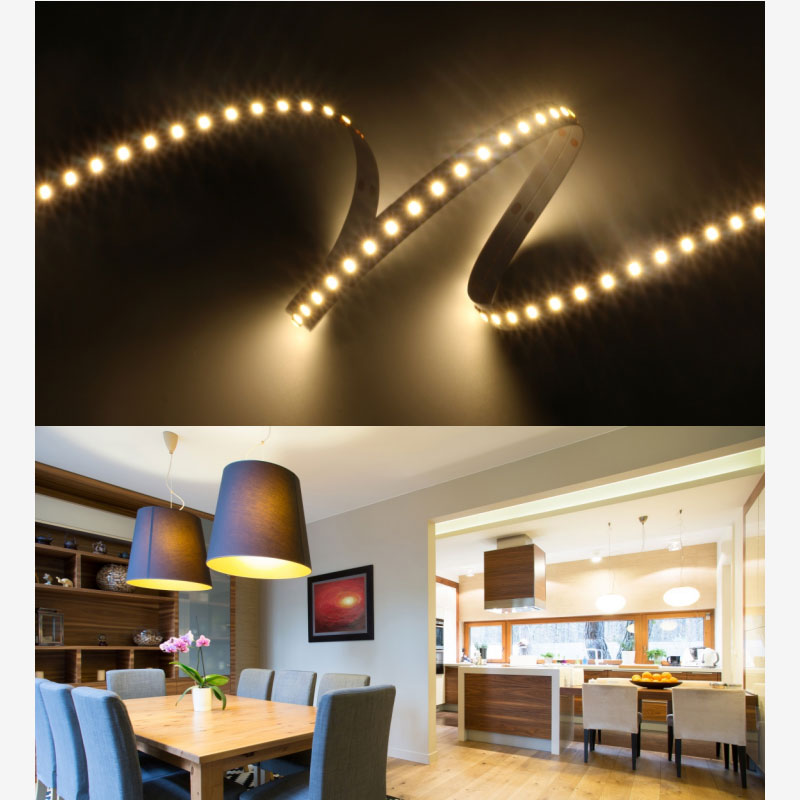What Makes LED Flexible Strips the Future of Modern Lighting Design?
2025-10-23
LED flexible strips, also known as LED tape lights or ribbon lights, are a modern lighting solution designed for versatility, efficiency, and aesthetic appeal. Built with a series of small light-emitting diodes (LEDs) mounted on a flexible circuit board, these strips can be cut, bent, and installed almost anywhere—making them ideal for both residential and commercial use. Unlike traditional lighting, LED flexible strips offer customizable brightness, color temperature, and length, allowing designers and homeowners to achieve tailored illumination for any environment.
The core advantage of LED flexible strips lies in their adaptability. They can be seamlessly integrated into furniture, ceilings, under-cabinet spaces, display shelves, and outdoor areas. With high energy efficiency and long lifespan, they not only reduce power consumption but also minimize maintenance costs. These features have made LED flexible strips a preferred choice for architects, interior designers, and lighting professionals aiming for innovative, sustainable lighting solutions.
Why Are LED Flexible Strips Considered a Smarter Lighting Choice?
Modern lighting trends emphasize efficiency, design freedom, and environmental responsibility—all of which LED flexible strips deliver exceptionally well. Their rise in popularity can be attributed to several key advantages:
-
Energy Efficiency: LED technology consumes up to 80% less electricity than incandescent bulbs, reducing both energy bills and carbon footprint.
-
Flexible Design: The ability to bend, cut, and extend allows LED strips to conform to curved surfaces, tight corners, and creative installations.
-
Dynamic Lighting Effects: Options like RGB, RGBW, and tunable white LEDs offer millions of color variations, supporting mood lighting and smart control systems.
-
Durability and Longevity: With a typical lifespan exceeding 50,000 hours, LED flexible strips significantly outlast traditional lighting systems.
-
Low Heat Emission: Unlike halogen or fluorescent lighting, LED strips operate at low temperatures, making them safe for contact surfaces and enclosed installations.
-
Environmentally Friendly: LED lights contain no toxic materials like mercury and are fully recyclable.
These benefits make LED flexible strips a smart choice for modern lighting applications ranging from home decoration to commercial branding and industrial illumination.
How Do LED Flexible Strips Work and What Specifications Matter Most?
LED flexible strips operate through a simple but highly efficient mechanism. Each strip is composed of surface-mounted LED chips soldered onto a flexible PCB (printed circuit board). Power is supplied via a DC voltage—typically 12V or 24V—which ensures stable illumination and easy installation.
When selecting the right LED flexible strip, it’s crucial to understand its technical specifications. Below is a detailed table outlining the essential parameters to evaluate before purchase or installation:
| Specification | Description | Typical Range / Option |
|---|---|---|
| Input Voltage | Determines power compatibility and brightness control. | 12V DC / 24V DC |
| LED Type | Defines brightness, efficiency, and color consistency. | SMD2835 / SMD5050 / SMD5630 |
| Color Temperature (CCT) | Indicates light warmth or coolness, measured in Kelvin (K). | 2700K (Warm White) – 6500K (Cool White) |
| Power Consumption | Impacts brightness and energy cost. | 4.8W/m – 20W/m |
| Luminous Flux | Measures total light output per meter. | 400 – 1800 lumens/m |
| Beam Angle | Determines light spread area. | 120° – 180° |
| IP Rating | Defines protection against dust and water. | IP20 (Indoor), IP65/IP67 (Outdoor) |
| CRI (Color Rendering Index) | Reflects how accurately colors appear under light. | >80 or >90 |
| Dimming Capability | Allows brightness adjustment with compatible drivers. | PWM / Triac / DALI / 0–10V |
| Lifespan | Duration of optimal performance. | 50,000+ hours |
| Operating Temperature | Range within which the strip performs reliably. | -20°C to +50°C |
These parameters directly influence the strip’s performance, durability, and suitability for specific applications. For example, SMD5050 LEDs are preferred for vibrant RGB effects, while SMD2835 models are optimal for uniform task lighting.
Additionally, installation accessories such as aluminum profiles, diffusers, connectors, and controllers enhance both performance and safety. When properly installed with quality drivers and heat dissipation systems, LED flexible strips deliver consistent illumination for years with minimal degradation.
What Are the Emerging Trends and Future of LED Flexible Strip Lighting?
As lighting technology evolves, LED flexible strips are becoming central to smart and sustainable lighting design. Several global trends are shaping the future of this industry:
-
Integration with Smart Home Systems: Compatibility with Wi-Fi, Bluetooth, Alexa, and Google Home enables remote control and automation of lighting scenes.
-
Human-Centric Lighting: Adjustable color temperatures (CCT) support circadian rhythm balance, improving comfort and productivity.
-
Ultra-High CRI LEDs: New-generation chips deliver color accuracy comparable to natural sunlight, enhancing retail and art display lighting.
-
Nanomaterial Coatings and Waterproofing: Advanced materials improve durability, flexibility, and outdoor performance.
-
Eco-Optimized Manufacturing: Reduced power consumption and recyclable materials align with global sustainability goals.
-
Architectural Integration: Designers now embed LED strips into structural elements—creating “invisible lighting” that redefines spatial aesthetics.
With these advancements, LED flexible strips are expected to dominate the decorative and functional lighting market for the next decade. They enable a seamless fusion of technology and design, offering limitless creative potential for architects, homeowners, and industrial engineers.
Common Questions About LED Flexible Strips
Q1: How can LED flexible strips be installed safely and efficiently?
A1: To ensure safe and efficient installation, always use the recommended power supply voltage (12V or 24V) and connect the strips using compatible drivers and connectors. It is crucial to mount the strips on heat-dissipating surfaces, such as aluminum channels, to prevent overheating. For outdoor or humid environments, select strips with an IP65 or IP67 waterproof rating. Avoid overloading circuits and ensure correct polarity connections to extend product lifespan.
Q2: Can LED flexible strips be dimmed or controlled via smartphone?
A2: Yes. Most modern LED flexible strips support dimming and remote control. By pairing the strips with a compatible dimmer, Wi-Fi controller, or smart hub, users can adjust brightness, switch colors, or set timers using smartphone apps or voice commands. This feature enhances both convenience and energy efficiency, allowing personalized lighting experiences for different spaces and moods.
How Do LED Flexible Strips Enhance Commercial and Residential Spaces?
The impact of LED flexible strips extends beyond illumination—they redefine ambiance, productivity, and brand perception.
-
Residential Use: LED strips can be installed under cabinets, behind mirrors, along staircases, or as ceiling accents to create ambient or task lighting. Their ability to adjust brightness and color supports both relaxing and energizing environments.
-
Commercial Use: In retail spaces, hotels, and restaurants, LED strips highlight architectural details and merchandise displays, attracting customer attention and reinforcing brand identity.
-
Industrial Applications: Factories and warehouses benefit from energy-efficient task lighting that improves visibility and safety while reducing operational costs.
-
Automotive and Outdoor Projects: Flexible LED strips are used in car interiors, signage, landscape lighting, and architectural façades, where durability and design flexibility are essential.
With growing awareness of sustainability, businesses are increasingly replacing conventional lighting with LED systems to align with green building standards and reduce energy expenditure.
The Future Outlook and the Role of Kons in LED Innovation
The LED flexible strip industry is projected to experience exponential growth driven by smart technology integration and global demand for sustainable illumination. Manufacturers continue to innovate with higher efficacy chips, advanced color rendering, and eco-conscious materials.
Kons stands at the forefront of this evolution—offering precision-engineered LED flexible strips that combine performance, reliability, and aesthetic excellence. With rigorous quality control and continuous R&D investment, Kons ensures that every lighting product delivers consistent brilliance and long-term efficiency.
For architects, designers, and project planners seeking trusted lighting partners, Kons provides customized LED lighting solutions tailored to both functional needs and artistic vision.
Contact us today to explore how Kons LED flexible strips can elevate your next lighting project with unmatched quality, versatility, and sustainability.



